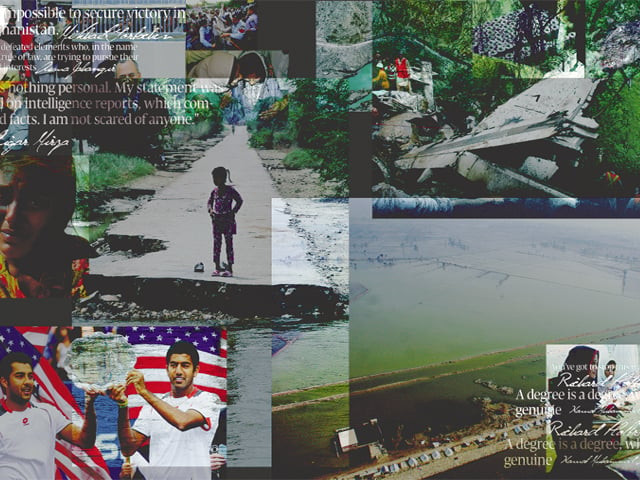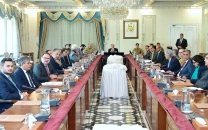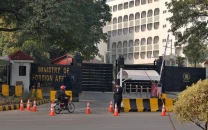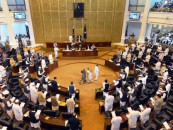Against the tide
Much of the home construction witnessed was being carried out with money provided through the Watan Cards.

Compare the call to the armed forces by as resourceful and efficient a state as Britain because of unusual snowfall to the summer 2010 floods in Pakistan that, according to the world Bank-ADB Floods Needs Assessment Report engulfed an area “equal in dimension to the land mass of the United Kingdom”. With 78 out of 130 odd districts of the country affected and 20 million people displaced, a large part of the country’s electronic media chose to politicise the natural disaster by creating a distinction between the ‘government’ and the ‘army’, with the former branded as villain and the latter a saviour. This politicisation of the floods in the media not only failed to provide perspective to the enormity of the disaster but has also jeopardized the reconstruction and rehabilitation effort.
To shout and shriek — as is the wont of TV anchors whose self righteousness is only matched by their shallowness — that nothing is being done by the government belies any serious introspection. Nowhere was it mentioned that before the floods, 45 million Pakistanis suffered from severe food insecurity, 40% of children under five were underweight and more than two-thirds of pregnant women in rural areas had never come across a trained medical practitioner through the course of their pregnancy. Yet, months after the floods, this broken state, along with international donors and local NGOs and philanthropists, has contained the damage heroically across a number of areas. Obviously the cameras are busy homing in on politicians and attempting to find new ways to affect regime change wired to them by their intel string-pullers.
This writer traveled across the flood-affected areas between October and December to assess the magnitude of reconstruction work required. Across eight districts in the four provinces visited, one witnessed the Biblical proportion of the disaster — three feet of water standing as far as one could see in Qambat Shahdadkot and Dera Murad Jamali, brick structure literally cut in half in Thatta and Charsadda, mud brick houses having collapsed in a heap everywhere and thousands of people still in camps across Sindh — but the number of positives to take home were in fact more stunning.
Nowhere in the 40-odd flood-affected villages and 20 camps visited, did one come across any trace of malnutrition or food shortage. In every tent and every home we saw an average of two bags of wheat with World Food Program, USAID, Turkish, Iranian or Italian government logos on them.
The ubiquitous blue toilets provided by UNICEF were not only found in camps but were taken back to the villagers by the flood affected people. Given the pre-flood state of hygiene in villages, this can only be the precursor to better hygiene practices in rural areas.
Perhaps the most remarkable observation was that in every single village and camp we were told that there was some form of medical attention provided to the flood victims. Virtually all children born in camps were attended by medical practitioners. A significant proportion of the people — particularly women and children who had never seen a doctor — had access to them after the floods. Moreover, given the scale of the disaster it also needs to be adequately understood as to how the death toll has been contained to roughly 2200. Was it adequate warning that allowed people to evacuate in time, reasonable provision of food, healthcare and hygiene in the camps and to the villages on their return, which has thus far prevented the spread of epidemics? Seeing the glass as half-empty as a default position prevents most from even beginning to understand this phenomenon.
Roughly half of the flood victims in the areas we visited had obtained the Watan Card. Chaos and corruption in the distribution of cards was evident — a number of people claimed that they had paid anywhere between Rs. 2000 to Rs. 5000 for the Rs. 20,000 benfit — but the government claims that 1.3 million cards had been distributed. Even if this is half true, this is a significant benefit provided by a broken state and a government that the urban upper and middle classes love to hate. In fact, much of the home construction witnessed was being carried out with money provided through the Watan Cards.
Moving ahead, a lot of work needs to be done. Agricultural lands have to be leveled, water courses repaired, silt and debris removed, schools, health centres, roads, bridges, culverts fixed and people’s livelihoods restored. While the help of NGOs, philanthropists and international disaster relief organisations was instrumental in relief work, the bulk of reconstruction is to be done by the state. International donors have already said, and rightly so, that unless Pakistanis do not contribute in the effort through enhanced taxation, how can they compel tax-payers in other countries to cough up this money. Rather than pushing the government to come up with a plausible and transparent reconstruction plan, the ruckus has been around the need to tax. If this naysayer mood continues, then the reconstruction work will falter and the political shape the urban-rural divide will then take can only be ominous.
Published in The Express Tribune, January 2nd, 2011.



















COMMENTS
Comments are moderated and generally will be posted if they are on-topic and not abusive.
For more information, please see our Comments FAQ